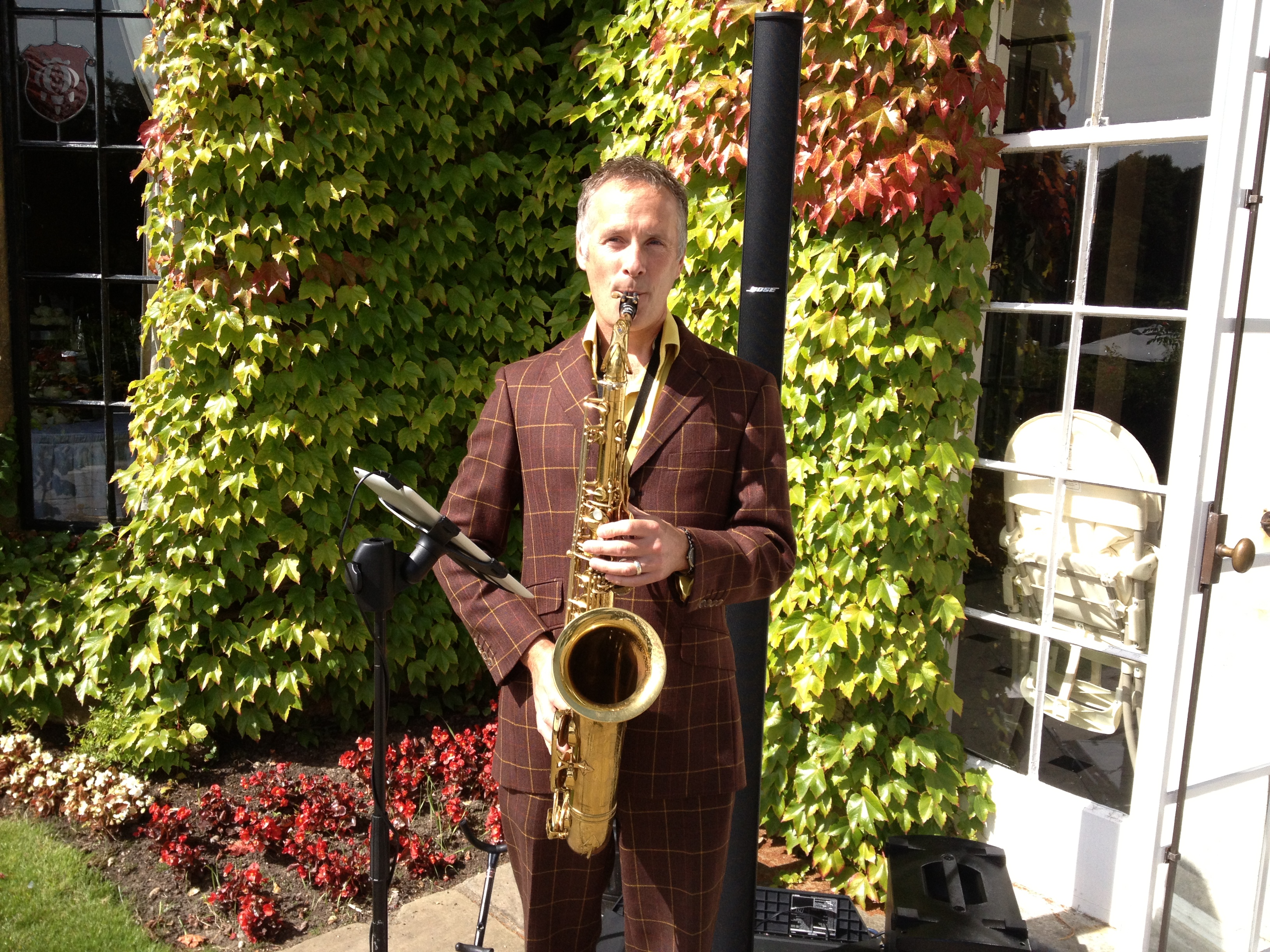Embouchure Exercises – There are many ways to practice and actively improve your playing without using your sax.
These include mental practice, physical exercise, breathing exercise, isometric exercise of your embouchure, and mouthpiece practice. I have found these techniques to be a valuable addition and enhancement of my regular daily practice. I have also found that these techniques help me maintain my musical abilities when I am away from my horns. While these techniques have worked very well for me, remember that no two people are exactly alike. You should modify these embouchure exercises so that they work best for you. Above all, be active in your practice. Practicing without a goal, without concentration, or “just going through the motions” can result in a loss of musical ability and is just a waste of your time.
During any day, there are many “down” times that do not require mental concentration. These are great times to use mental practice to improve your musical ability. This is a technique that many excellent musicians and sports figures use to improve their performance. Remember that mental practice will take all of your concentration. Do not attempt these exercises when your attention is needed elsewhere – for example, while driving. You can mentally practice anything from simple technical exercises to short musical phrases to complete solos or songs. While mentally practicing, imagine all of the senses you experience while playing your sax. Since you are using your imagination, use your mind’s ear to hear the most beautiful tone possible. Imagine a technically accurate and musical performance. Mental practice is a good way to help alleviate stage fright. Visualize yourself on stage confidently performing with musical and technical perfection. In National Lampoon’s Vegas Vacation, Wayne Newton states “a singer’s body is his instrument and I believe in keeping my instrument finely tuned.” While this statement was used for comedic effect in the movie, it is a statement that is true for all musicians. Your body is your instrument and you should keep it finely tuned. Aerobic and cardio-vascular exercises such as brisk walking, running, or swimming will help develop lung capacity. Sit-ups help develop abdominal muscle strength. Push-ups help develop both abdominal and intercostal muscle strength. You should try to keep your throat, tongue, facial muscles, and fingers relaxed while exercising. This separation of muscle groups mimics performance. When you play your horn you have to contract your abdominal and intercostal muscles while keeping your throat, tongue, fingers, and arms relaxed. Staying physically fit will also help the mental aspects of playing.
Your body is your instrument and your lungs are its power supply. Breathing exercises will help you develop lung capacity and intercostal strength. The breathing exercise that I like is as follows. While walking briskly breathe in for five steps (a full breath), hold for five steps, breathe out for five steps (exhale completely), hold for five steps, and repeat. You can modify this exercise by adjusting the number of steps either up or down. You can do this exercise anytime that you are walking. It will help your upper range and your ability to play longer phrases. When doing this exercise, practice keeping your throat, tongue, facial muscles, and fingers relaxed.
Brass players, especially those who play in the upper register, must have embouchures with very firm corners. Firm corners help secure the upper register, increase endurance, and reduce excessive mouthpiece pressure. You can use isometric exercise of the embouchure muscles, especially the orbicular oris, to help strengthen the corners. To do this exercise, form your embouchure and firm the corners. Hold this set until the corners start to burn. Once you feel the burn, try to hold your set for an additional one to two minutes. Do this exercise two are three times each day. As with any exercise, try to isolate the muscles you are working on by keeping all other muscles as relaxed as possible. It is especially important to keep your tongue relaxed. It also helps to keep your breathing regular and relaxed.
- EMBOUCHURE EXERCISES 1–THE GOOD OLD PENCIL THING
Get a wood pencil. Close your teeth, and place the un-sharpened end against them. Wrap your lips around the pencil, and let go, holding the pencil straight out in front of your face with only the muscles in the lips and surrounding area. Continue holding it straight out until your muscles burn. Rest. Repeat.
- EMBOUCHURE EXERCISES 2–PUCKER UP
Push your lips out as far as you can in an overly exaggerated pucker. Now focus the energy even harder, as if you have to hold some tiny object “in” this pucker by drawing your lips into an extremely tight drawstring effect. Hold this position until the muscles burn. Rest. Repeat.
- EMBOUCHURE EXERCISES 3—PUCKER-SMILE
As in Exercise 2, push your lips into the most concentrated pucker possible. Now reverse that facial expression and smile as widely as possible. Alternate between these two positions as fast as you can. Do this until the muscles burn. Rest. Repeat.
This is a DAILY regimen. Alternate these exercises in each “session” and keep it up for a couple of months MINIMUM. You will see results much sooner than that, but what you are trying to do is build the muscle in your face to extreme levels of size and strength. After a couple of months, every other day will maintain your progress. As with any physical conditioning, progress will come in leaps and plateaus. It’s important to keep exercising through the plateaus to reach the next leap. It is also VERY important to do each of these exercises until you feel pain in the muscles being worked. Unlike playing the horn until you feel discomfort, which is highly destructive, the “pain” you feel in these exercises are the muscles telling the body and brain, “HEY, I need some help here, sign me up for some increased tissue.” It’s the equivalent of sending your face to the gym for some serious buffing up.
- The first exercise consists of merely holding your lips closed, as in saying the *mmm* sound. When done correctly, this requires you to slightly roll your lips inward… Hold this position for as long as possible (you’ll eventually be able to do it for hours at a time), until your muscles begin to burn, then rest an equivalent amount of time before repeating.
- The second exercise is like the first, except that this time, besides the *mmm* position, you should also draw the lip muscles in, toward the centre of your lips (avoid an obvious pursing, however). You should feel as though your lip muscles are *hugging* against your teeth. It is also important to keep the corners where they are when your mouth is relaxed while you are doing this (neither stretched outward into a *smile* nor drawn down as in a frown). Once again, hold until the muscles develop the lactic acid *burn*, then release, rest, and repeat…
- This one is best done before a mirror, at least the first few times that you perform it, until you are sure that you are correctly performing the exercise. While observing yourself in the mirror, complete the following movements:
- a). Roll your bottom lip out as far as possible. (Try to touch your chin with it). Be sure to keep the upper lip in contact with the inside of the bottom lip as you are doing this. Hold in the extended position for a count of ten, then gradually roll the bottom lip back up, so that it is hugging the outside of the upper lip. Rest. Repeat.
- b). Purse your lips as far forward as possible. Hold for a count of ten, then gradually relax them. Rest. Repeat.
- c). Roll your lips inward, so that the red (membrane) of your lips disappears. Be sure that both lips are in front of the teeth as you do this. Hold for a count of ten. Rest. Repeat.
Understanding the role of the facial muscles, lips, and teeth in creating the sound is essential to producing a quality saxophone tone. Most importantly, these components should work together to form an embouchure that controls the speed and evenness with which the reed vibrates, without inhibiting these same vibrations.
With this in mind, think of the lower lip as being a firm mattress upon which the reed rests. The objective is to provide support for the reed without pinching or biting with the lower teeth. This means that the teeth should be pulled down while maintaining constant firmness with the muscles in the lower lip and corners of the mouth.
It is important that the muscles controlling the upper and lower lips be focused inward rather than stretched in a smiling position. This inward focus should result in a round or oval-shaped embouchure that seals around the mouthpiece. The difficulty is keeping the lower lip firm during this process. One way of knowing that the teeth and facial muscles are in the proper position and functioning correctly is that the chin should be flat when the embouchure is sustained. This position may be achieved relatively easily at first, but students often have difficulty maintaining control over these muscles while playing. For this reason, I have included some exercises for achieving, strengthening, and playing with the correct saxophone embouchure.
A common saxophone embouchure exercise involves closing the teeth in a relaxed manner. Without biting, press the upper and lower lips firmly together. Keep the corners of the mouth in place and the lips pressed firmly together as you separate the teeth as far as possible. Sustain this position until you feel fatigue, then rest and repeat the process. Done daily, this exercise will serve to strengthen the muscles used in forming your embouchure.
A variation of the embouchure exercise described above is also helpful in setting the embouchure for playing. Close the teeth without biting. Press the lips firmly together. This time separate the teeth enough that you can stick the tip of your tongue between them while keeping the lips pressed firmly. Retract the tongue and push the lower teeth forward (assuming you have a slight overbite) into the lower lip. Keeping the teeth in this position, separate the lips and place the mouthpiece into your mouth with the upper teeth resting on the top of the mouthpiece and the lower lip making contact with the reed. Focus the corners of your mouth inward to close securely around the mouthpiece. Be certain that the chin stays flat and the lower teeth down during this process.
Another important consideration in setting the embouchure is knowing exactly how much mouthpiece to place in the mouth. Hold the mouthpiece sideways so that you can see the angle at which the reed and rails of the mouthpiece come together; then place your thumbnail at the intersection. This marks the approximate amount of mouthpiece that should enter the mouth. Listen to the tone when you play. If it is thin or dead sounding, you may need to place more mouthpiece in your mouth. If the tone has a duck or goose-like quality to it, chances are that you have too much mouthpiece in your mouth. By listening for the sweet spot, you will eventually learn to feel the right bite on the mouthpiece.
Embouchure exercises
- Put the index finger on your bottom lip. Press lip over bottom teeth and pull down. This will hurt unless you resist by lifting your bottom lip up and away from the teeth, using the facial muscles in conjunction with muscles in the bottom lip.
- Play long tones with upper lip off the mouthpiece.
- Bring the corners down as far as you can, independent of all other facial, lip and chin muscles.
- Integrate all of this with the long tones, embouchure studies and scales throughout the full range. Keep a stationary embouchure.
THROAT- Open in “Hee” position.
BREATHING- Stomach muscles press against the resistance of the diaphragm.
TONGUING- “ee” position. The tip of the tongue is placed on the tip of the reed. (approximately 1/16-1/8 inch from the top of the reed). This is the natural resting position of the tongue when the mouthpiece is in your mouth. Form an embouchure – apply air pressure and then release and return the tongue. The tone should sound full if the support is sufficient and the release is accurate. All the while air pressure must continue from the abdominal muscles, even when there isn’t any sound, due to the placement of the tongue on the reed. The air does most of the work in tonguing. We only use the very front part of the
tongue – sing “ee”. That keeps the rest of our tongue stationary – then “tee-tee-teetee”. An excellent exercise is to hypothetically spit something off the tip of your tongue. Another similar exercise is to form a small aperture (flute embouchure). Blow air through, release and return the very tip of the tongue, keeping the air speed intense all the while.
The best approach to tonguing is the achievement of good legato tonguing, which will lead to a good staccato tongue.










